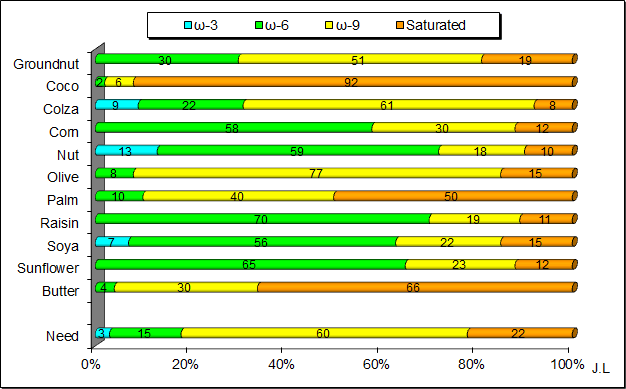
Characteristics of lipids
Lipids are constituted about 98% of triglycerids which are combinations of three fatty acids and glycerol.
Remaining 2% are phospholipids (lecithins), sterols (cholesterol, ergosterol) and liposoluble vitamins (A,D,E,K).
There are seven main fatty acids in our body.
Fatty acids are categorized by the Greek letter omega (ω), and a number designating the position of the carbon-carbon double bond.
Poly-unsaturated fatty acids
Named essential fatty acids, they are indispensable because our body is not capable to produce them.
They are contained in the vegetable oils and the fat fishes (salmon, tuna, sardines, etc.).
The alpha linolenic acid (ω-3) is contained in oil of nut, colza, soya.
The linoleic acid (ω-6) is contained in oil of sunflower, nut, corn, soya.
These acids are sub-used in the food.
Mono-unsaturated fatty acids
They are the most common and not essential because our body can produce them.
The oleic acid (ω-9) is contained in the majority of oils, it is stable in temperature.
It is the most spread fatty acid in our body which can produce it from the glucose.
Saturated fatty acids
They are the less good because they increase the rate of the bad cholesterol (LDL).
They are contained in meats, eggs, dairies.
The palmitic acid (very spread in our body), lauric, myristic, stearic are the most common.
These acids are unfortunately over-used in the food.
Composition of oils (and butter) in fatty acids

Trans fatty acids
These are unsaturated acids generally derived from industrial techniques.
They are harmful because our body does not know how to treat these artificial acids.
They are contained in the margarines, oils, industrial foods where it is mentioned "partially hydrogenated fat".